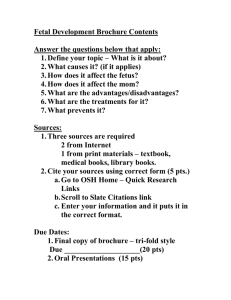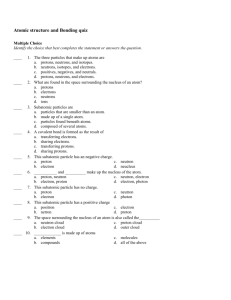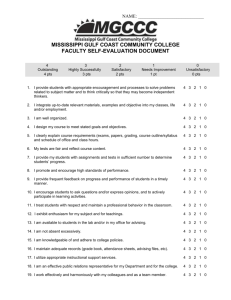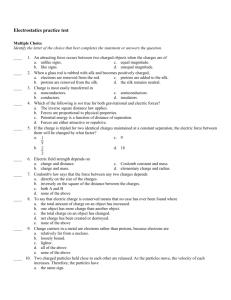chapter 10—sustaining terrestrial biodiversity: the
advertisement
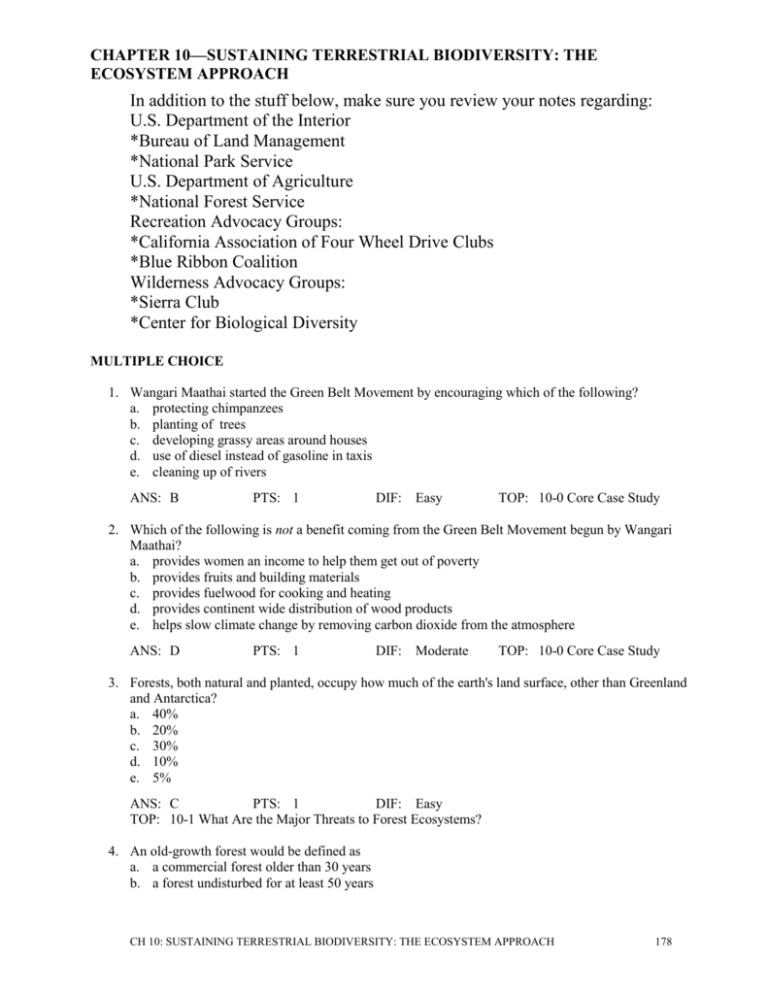
CHAPTER 10—SUSTAINING TERRESTRIAL BIODIVERSITY: THE ECOSYSTEM APPROACH In addition to the stuff below, make sure you review your notes regarding: U.S. Department of the Interior *Bureau of Land Management *National Park Service U.S. Department of Agriculture *National Forest Service Recreation Advocacy Groups: *California Association of Four Wheel Drive Clubs *Blue Ribbon Coalition Wilderness Advocacy Groups: *Sierra Club *Center for Biological Diversity MULTIPLE CHOICE 1. Wangari Maathai started the Green Belt Movement by encouraging which of the following? a. protecting chimpanzees b. planting of trees c. developing grassy areas around houses d. use of diesel instead of gasoline in taxis e. cleaning up of rivers ANS: B PTS: 1 DIF: Easy TOP: 10-0 Core Case Study 2. Which of the following is not a benefit coming from the Green Belt Movement begun by Wangari Maathai? a. provides women an income to help them get out of poverty b. provides fruits and building materials c. provides fuelwood for cooking and heating d. provides continent wide distribution of wood products e. helps slow climate change by removing carbon dioxide from the atmosphere ANS: D PTS: 1 DIF: Moderate TOP: 10-0 Core Case Study 3. Forests, both natural and planted, occupy how much of the earth's land surface, other than Greenland and Antarctica? a. 40% b. 20% c. 30% d. 10% e. 5% ANS: C PTS: 1 DIF: Easy TOP: 10-1 What Are the Major Threats to Forest Ecosystems? 4. An old-growth forest would be defined as a. a commercial forest older than 30 years b. a forest undisturbed for at least 50 years CH 10: SUSTAINING TERRESTRIAL BIODIVERSITY: THE ECOSYSTEM APPROACH 178 c. a second-growth forest undisturbed for at least 100 years d. a re-planted forest that has had little disturbance for 100 years e. an uncut or regenerated primary forest undisturbed for several hundred years ANS: E PTS: 1 DIF: Easy TOP: 10-1 What Are the Major Threats to Forest Ecosystems? 5. A second-growth forest is a. an old-growth forest with lots of new seedlings b. an old growth forest with lots of weeds c. trees resulting from secondary succession d. an old growth forest that has been cut down with only weeds remaining e. grassland that has been planted with seedlings ANS: C PTS: 1 DIF: Easy TOP: 10-1 What Are the Major Threats to Forest Ecosystems? 6. Which of the following is not among the countries with the largest areas of old-growth forests? a. Russia b. Canada c. Brazil d. Indonesia e. United States ANS: E PTS: 1 DIF: Easy TOP: 10-1 What Are the Major Threats to Forest Ecosystems? 7. Which of the following is not true of tree plantations? a. They are biologically highly diverse. b. They can return a fast profit. c. They are usually clear cut when sufficiently mature. d. The trees are often used for paper or reconstituted wood substitute. e. The trees are uniformly aged. ANS: A PTS: 1 DIF: Moderate TOP: 10-1 What Are the Major Threats to Forest Ecosystems? 8. Four of the following are true about tree plantations; one is not. Choose the one that is not true. a. Repeated cycles of cutting and replanting deplete soil nutrients. b. Soil may become so depleted it hinders any type of forest growth. c. They probably are more sustainable than old-growth or second-growth forests. d. They have less biodiversity than old-growth or second-growth forests. e. They are controversial because of genetically engineered tree species. ANS: C PTS: 1 DIF: Difficult TOP: 10-1 What Are the Major Threats to Forest Ecosystems? 9. Four of the following are important ecological services provided by forests; one is not. Choose the one that is not. a. Reduce soil erosion. b. Release atmospheric carbon. c. Purify water and air. d. Influence local and regional climate. e. Provide numerous wildlife habitats. ANS: B PTS: 1 DIF: Easy TOP: Figure 10-4 CH 10: SUSTAINING TERRESTRIAL BIODIVERSITY: THE ECOSYSTEM APPROACH 179 10. Which of the following is not an economic service provided by forests? a. fuelwood b. mining c. reduce erosion d. lumber e. recreation ANS: C PTS: 1 DIF: Moderate TOP: 10-1 What Are the Major Threats to Forest Ecosystems? 11. Four of the following are true about forests; one is not. Choose the one that is not true. a. They are home to one-half of the world's people. b. Traditional medicine, used by 80% of the world's people, comes from forests. c. Chemicals from old-growth forests are used to make most medicines. d. Forests are habitat for two-thirds of terrestrial species. e. One-fourth of world's people depend on forests for their livelihoods. ANS: A PTS: 1 DIF: Moderate TOP: 10-1 What Are the Major Threats to Forest Ecosystems? 12. Robert Costanza of the University of Vermont estimates the monetary worth of the earth’s ecological services per year at which of the following? a. $150 billion b. $500 billion c. $1.5 trillion d. $33 trillion e. $500 trillion ANS: D PTS: 1 DIF: Easy TOP: Science Focus - Putting a Price Tag on Nature's Ecological Services 13. Robert Costanza of the University of Vermont estimates the world’s forests provide us with ecological services worth how much per year? a. $4.7 trillion b. $6.3 trillion c. $11.9 trillion d. $13.2 trillion e. $15 trillion ANS: A PTS: 1 DIF: Easy TOP: Science Focus - Putting a Price Tag on Nature's Ecological Services 14. Even carefully designed logging roads have harmful effects, including all of the following except a. increased erosion b. sediment runoff into waterways c. habitat fragmentation d. decreased access to farms, mines, and ranches e. loss of diversity ANS: D PTS: 1 DIF: Moderate CH 10: SUSTAINING TERRESTRIAL BIODIVERSITY: THE ECOSYSTEM APPROACH 180 TOP: 10-1 What Are the Major Threats to Forest Ecosystems? 15. Removing intermediate-aged or mature trees from a forest is known as a. intermediate cutting b. selective cutting c. partial cutting d. clear-cutting e. strip-cutting ANS: B PTS: 1 DIF: Moderate TOP: 10-1 What Are the Major Threats to Forest Ecosystems? 16. Clear-cutting does all of the following except a. eliminates most recreational value b. destroys and fragments wildlife habitats c. increases flooding and erosion d. enhances biodiversity e. increases pollution of streams ANS: D PTS: 1 DIF: Moderate TOP: Figure 10-8: Trade-Offs: Clear-Cutting Forests 17. Which of the following is not true about surface fires? a. They free valuable mineral nutrients tied up in decomposing litter. b. They release seeds from cones of lodgepole pines. c. They increase soil erosion. d. Wildlife requires surface fires to maintain their habitats. e. They help control diseases. ANS: C PTS: 1 DIF: Moderate TOP: 10-1 What Are the Major Threats to Forest Ecosystems? 18. Which of the following is the most dangerous type of fire? a. surface b. prescribed c. ground d. crown e. designated ANS: D PTS: 1 DIF: Easy TOP: 10-1 What Are the Major Threats to Forest Ecosystems? 19. Which of the following statements is false? a. Wildlife and mature trees are relatively unharmed by surface fires. b. Surface fires increase the chance of a severe crown fire. c. Surface fires release minerals that are locked up in vegetation. d. Surface fires may benefit some plant species and some game animals. e. Surface fires burn away flammable ground material, helping prevent destructive fires. ANS: B PTS: 1 DIF: Moderate TOP: 10-1 What Are the Major Threats to Forest Ecosystems? CH 10: SUSTAINING TERRESTRIAL BIODIVERSITY: THE ECOSYSTEM APPROACH 181 20. Controlling or reducing the harmful impacts of tree diseases and insect pests on forests can be accomplished by all of the following except a. introducing nonnative predators for the insects b. banning imported timber that might carry new diseases or insects c. developing genetically resistant tree species d. applying conventional pesticides e. using biological controls such as predaceous local bugs ANS: A PTS: 1 DIF: Difficult TOP: 10-1 What Are the Major Threats to Forest Ecosystems? 21. The temporary or permanent removal of large expanses of forest for agriculture, or other uses, is called a. reforestation b. deforestation c. selective cutting d. strip cutting e. sustainable harvesting ANS: B PTS: 1 DIF: Easy TOP: 10-1 What Are the Major Threats to Forest Ecosystems? 22. Over the past 8,000 years, human activities have reduced the earth’s original forest cover by about _____ %, with most of that coming in the last 60 years. a. 46 b. 32 c. 64 d. 76 e. 58 ANS: A PTS: 1 DIF: Moderate TOP: 10-1 What Are the Major Threats to Forest Ecosystems? 23. According to the World Resources Institute, if the current rates continue, how much of the world's remaining forests will be lost in the next two decades? a. 10% b. 20% c. 30% d. 40% e. 50% ANS: D PTS: 1 DIF: Easy TOP: 10-1 What Are the Major Threats to Forest Ecosystems? 24. Forests cover about ____% of the U.S. land area. a. 0 b. 3 c. 10 d. 30 e. 50 ANS: D PTS: 1 DIF: Moderate CH 10: SUSTAINING TERRESTRIAL BIODIVERSITY: THE ECOSYSTEM APPROACH 182 TOP: 10-1 What Are the Major Threats to Forest Ecosystems? 25. In the United States, about ____% of the forests are protected. a. 10 b. 20 c. 30 d. 40 e. 50 ANS: D PTS: 1 DIF: Easy TOP: 10-1 What Are the Major Threats to Forest Ecosystems? 26. Brazil's government has stated that the percentage of Amazon basin that has been deforested or degraded has increased from 1% in 1970 to ____% in 2008. a. 2 b. 4 c. 8 d. 20 e. 32 ANS: D PTS: 1 DIF: Moderate TOP: 10-1 What Are the Major Threats to Forest Ecosystems? 27. The major causes of destruction and degradation of tropical forests includes all of the following except a. not valuing ecological services b. crop and timber exports c. illnesses of trees and other plants d. population growth e. poverty ANS: C PTS: 1 DIF: Difficult TOP: 10-1 What Are the Major Threats to Forest Ecosystems? 28. Tropical forests in the Amazon basin and other South American countries are being cleared for all of the following except a. tree plantations b. cattle ranching c. tropical hardwood lumber d. soybean plantations e. coffee and spices ANS: E PTS: 1 DIF: Moderate TOP: 10-1 What Are the Major Threats to Forest Ecosystems? 29. Burning tropical forests accounts for how much of the human-created greenhouse gas emissions? a. 6% b. 11% c. 17% d. 23% e. 27% ANS: C PTS: 1 DIF: Easy TOP: Connections: Burning Tropical Forests and Climate Change CH 10: SUSTAINING TERRESTRIAL BIODIVERSITY: THE ECOSYSTEM APPROACH 183 30. Four of the following are ways to grow and harvest trees more sustainably; one is not. Choose the one that is not. a. No clear-cutting on steep slopes. b. No logging of old-growth forests. c. Identify and protect forest areas high in biodiversity. d. Leave most standing dead trees. e. Increase road building into uncut areas. ANS: E PTS: 1 DIF: Easy TOP: Figure 10-16 Solutions: More Sustainable Forestry 31. Ecologists and forest fire experts recommend several strategies for reducing fire-related harm to forests and people. Which of the following is not one of those strategies? a. Encourage growth of young trees and underbrush. b. Set small, contained surface fires in highest-risk forest areas. c. Allow fires on public lands to burn as long as they do not threaten lives. d. Thin a zone of 60 meters around houses and buildings in fire prone areas. e. Thin forest areas vulnerable to fire by clearing away fire-prone trees and underbrush. ANS: A PTS: 1 DIF: Difficult TOP: 10-2 How Should We Manage and Sustain Forests? 32. One of the reasons for cutting trees is to provide pulp for making paper. However, paper can be made from all of the following except a. rice straw b. animal fats c. hemp d. agricultural residues e. kenaf ANS: B PTS: 1 DIF: Moderate TOP: 10-2 How Should We Manage and Sustain Forests? 33. Hemp and which other source of pulp require fewer pesticides and yield more pulp per hectare? a. rice straw b. animal fats c. wood d. agricultural residues e. kenaf ANS: E PTS: 1 DIF: Moderate TOP: 10-2 How Should We Manage and Sustain Forests? 34. With only 2% of its forests remaining, which of the following countries has gone from tropical paradise to ecological disaster? a. Jamaica b. Bermuda c. Haiti d. Cuba e. Virgin Islands ANS: C PTS: 1 DIF: Moderate TOP: 10-2 How Should We Manage and Sustain Forests? CH 10: SUSTAINING TERRESTRIAL BIODIVERSITY: THE ECOSYSTEM APPROACH 184 35. The demand for fuelwood is a major factor in the degrading of forests. Which of the following is not true about the use of wood for cooking and heating? a. Used by more than 2 billion people. b. Consumes about three-fourths of all the wood harvested in developing countries. c. Causes rings of deforested lands around urban centers. d. Is heavily sold on the black market. e. In less than 50 years demand may be 50% greater than sustainable supply. ANS: D PTS: 1 DIF: Difficult TOP: 10-2 How Should We Manage and Sustain Forests? 36. Which of the following can be used to reduce tropical deforestation? a. educate settlers about sustainable forestry/agriculture. b. certify sustainably grown timber c. reduce poverty d. protect the most diverse and endangered areas e. All of these. ANS: E PTS: 1 DIF: Easy TOP: Figure 10-19 Solutions: Sustaining Tropical Forests 37. Unfenced grasslands in tropical and temperate climates that supply forage for grazing animals are called a. pastures b. rangeland c. savannah d. steppes e. veldt ANS: B PTS: 1 DIF: Easy TOP: 10-3 How Should We Manage and Sustain Grasslands? 38. Overgrazing occurs when too many animals graze for too long and exceed the carrying capacity of a rangeland area. Overgrazing causes all of the following except a. reduced grass cover b. exposure of the soil to wind erosion c. increased retention of water d. compacted soil e. encourages invasion by inedible plant species ANS: C PTS: 1 DIF: Moderate TOP: 10-3 How Should We Manage and Sustain Grasslands? 39. Which of the following is not a method of grassland restoration? a. protection of riparian areas from overgrazing b. rotation of water holes and salt blocks c. suppression of growth of unwanted invader plants by herbicide spraying d. use of portable fencing to confine cattle to ungrazed areas e. removal of native grasses to reduce growth ANS: E PTS: 1 DIF: Difficult TOP: 10-3 How Should We Manage and Sustain Grasslands? CH 10: SUSTAINING TERRESTRIAL BIODIVERSITY: THE ECOSYSTEM APPROACH 185 40. Efforts to sustain the key remaining grasslands and habitats in the Southwestern US includes all of the following except a. conservation easements b. pressure local governments to allow large-scale development in fragile areas c. ranchers reducing the impact of their herds d. using far less fertilizer and pesticides e. prevent large-scale development in fragile areas ANS: B PTS: 1 DIF: Moderate TOP: 10-3 How Should We Manage and Sustain Grasslands? 41. Which of the following is one of the biggest problems for U.S. national parks today? a. popularity b. too many concessions c. invasion of alien species d. rock collectors e. soil erosion ANS: A PTS: 1 DIF: Easy TOP: 10-4 How Should We Manage and Sustain Parks and Nature Reserves? 42. Which of the following is not a major problem for U.S. public parks? a. introduction of nonnative species b. killing of native species c. polluted air d. agricultural runoff e. deferred repairs of infrastructure ANS: D PTS: 1 DIF: Moderate TOP: 10-4 How Should We Manage and Sustain Parks and Nature Reserves? 43. The world's largest system of private natural areas and wildlife sanctuaries has been created by a. European Union b. U.S. government c. United Nations d. Sierra Club e. Nature Conservancy ANS: E PTS: 1 DIF: Easy TOP: 10-4 How Should We Manage and Sustain Parks and Nature Reserves? 44. The United Nations and conservationists around the world are using a design in which an inner core of a reserve is surrounded by two protective areas. This design is known as a. habitat corridors b. buffer zone concept c. wilderness concept d. transition zones e. reserve concept ANS: B PTS: 1 DIF: Moderate TOP: 10-4 How Should We Manage and Sustain Parks and Nature Reserves? 45. Protected areas linking isolated reserves is a design called CH 10: SUSTAINING TERRESTRIAL BIODIVERSITY: THE ECOSYSTEM APPROACH 186 a. b. c. d. e. habitat corridors buffer zone concept wilderness concept transition zones reserve concept ANS: A PTS: 1 DIF: Moderate TOP: 10-4 How Should We Manage and Sustain Parks and Nature Reserves? 46. Which of the following is a "superpower of biodiversity" with an estimated 500,000 plant and animal species? a. Panama b. Nicaragua c. Costa Rica d. Guatemala e. El Salvador ANS: C PTS: 1 DIF: Easy TOP: 10-4 How Should We Manage and Sustain Parks and Nature Reserves? 47. Large areas of undeveloped land that has not been seriously disturbed by humans is called a. national parks b. reserves c. national forests d. biospheres e. wilderness ANS: E PTS: 1 DIF: Easy TOP: 10-4 How Should We Manage and Sustain Parks and Nature Reserves? 48. In 1995-1996 gray wolves were re-introduced to Yellowstone National Park. Since then all of the following have occurred, except a. remains of elk killed by wolves have become food for grizzly bears b. beaver dams have disappeared from the streams c. wary elk no longer trample regrowth of aspen, cottonwoods, and willow trees d. shade trees growing along streams have encouraged larger trout populations e. wolves have reduced predatory coyote populations increasing small mammals ANS: B PTS: 1 DIF: Difficult TOP: Science Focus: Reintroducing the Gray Wolf to Yellowstone National Park 49. The ecosystem approach to sustaining biodiversity follows four of the following principles. Choose which one is not one of these principles. a. Map global ecosystems and create an inventory of the species. b. Locate and protect the most endangered ecosystems. c. Seek to restore as many degraded ecosystems as possible. d. Allow the heavily degraded ecosystems to disappear. e. Make development biodiversity friendly by providing financial incentives. ANS: D PTS: 1 DIF: Moderate TOP: 10-5 What Is the Ecosystem Approach to Sustaining Biodiversity? CH 10: SUSTAINING TERRESTRIAL BIODIVERSITY: THE ECOSYSTEM APPROACH 187 50. Four of the following are measures to restore ecosystems; one is not. Choose the one that is not. a. rehabilitation b. secondary succession c. replacement d. creating artificial ecosystems e. restoration ANS: B PTS: 1 DIF: Moderate TOP: 10-5 What Is the Ecosystem Approach to Sustaining Biodiversity? 51. Researchers have suggested four principles for carrying out most forms of ecological restoration and rehabilitation. Which one of the following is not one of the principles? a. Find the cause of the degradation. b. Stop the abuse by eliminating the causes. c. Encourage the development of economic zones in the ecosystem. d. Reintroduce species, especially keystone, foundation, and pioneer species. e. Protect the area from further degradation. ANS: C PTS: 1 DIF: Difficult TOP: 10-5 What Is the Ecosystem Approach to Sustaining Biodiversity? 52. Michael Rosenzweig suggests we need to learn how to share with other species the spaces we dominate. He calls this new form of conservation biology a. reconciliation ecology b. rehabilitation ecology c. refurbishment biology d. community building e. formation building ANS: A PTS: 1 DIF: Moderate TOP: 10-5 What Is the Ecosystem Approach to Sustaining Biodiversity? 53. What can you do to help sustain terrestrial biodiversity? All of the following are things each of us can do, except a. Plant trees and take care of them. b. Recycle paper and use recycled products. c. Buy sustainable wood and wood products. d. Help restore nearby degraded forests or grasslands. e. Do not plant your yard with local plants. ANS: E PTS: 1 DIF: Moderate TOP: Figure 10-28 What Can You Do? Sustaining Terrestrial Biodiversity TRUE/FALSE 1. The Green Belt Movement is a women’s self-help group in rural Kenya. ANS: T PTS: 1 DIF: Easy TOP: 10-0 Core Case Study 2. Someday, tree plantations may supply most of the world's demand for industrial wood. ANS: T PTS: 1 DIF: Easy TOP: 10-1 What Are the Major Threats to Forest Ecosystems? CH 10: SUSTAINING TERRESTRIAL BIODIVERSITY: THE ECOSYSTEM APPROACH 188 3. Tree farms are more biologically diverse than second-growth forests. ANS: F PTS: 1 DIF: Easy TOP: 10-1 What Are the Major Threats to Forest Ecosystems? 4. A 1997 report estimated the value of the ecological services provided to humans by forests to be at least $4.7 trillion. ANS: T PTS: 1 DIF: Easy TOP: 10-1 What Are the Major Threats to Forest Ecosystems? 5. Sixty percent of the world’s forests are old-growth forests. ANS: F PTS: 1 DIF: Easy TOP: 10-1 What Are the Major Threats to Forest Ecosystems? 6. Illegal, uncontrolled, and unsustainable logging is taking place in at least 70 countries, especially in Africa and Southeast Asia. ANS: T PTS: 1 DIF: Easy TOP: 10-1 What Are the Major Threats to Forest Ecosystems? 7. Forest fires are not a major threat to forest ecosystems as part of a natural cycle. ANS: T PTS: 1 DIF: Easy TOP: 10-1 What Are the Major Threats to Forest Ecosystems? 8. Crown fires are strictly the result of droughts. ANS: F PTS: 1 DIF: Easy TOP: 10-1 What Are the Major Threats to Forest Ecosystems? 9. Deforestation is proceeding at a rate of 0.3 to 0.8% per year, which is not a pace that is a concern to scientists. ANS: F PTS: 1 DIF: Easy TOP: 10-1 What Are the Major Threats to Forest Ecosystems? 10. Tropical forests are being lost at a rate equal to the total area of the state of Mississippi each year. ANS: T PTS: 1 DIF: Moderate TOP: 10-1 What Are the Major Threats to Forest Ecosystems? 11. In the last 8,000 years, humans have reduced the earth's original forest cover by about 23%. ANS: F PTS: 1 DIF: Easy TOP: 10-1 What Are the Major Threats to Forest Ecosystems? 12. Today the forests of the United States cover more area than they did in 1920. ANS: T PTS: 1 DIF: Easy TOP: 10-1 What Are the Major Threats to Forest Ecosystems? CH 10: SUSTAINING TERRESTRIAL BIODIVERSITY: THE ECOSYSTEM APPROACH 189 13. Forests covering approximately 30% of the U.S. land area supply about two-thirds of the nation's surface water. ANS: T PTS: 1 DIF: Moderate TOP: 10-1 What Are the Major Threats to Forest Ecosystems? 14. If current deforestation rates continue about 40% of all the world’s remaining intact forests will have been logged or converted to other uses in 20 years. ANS: T PTS: 1 DIF: Easy TOP: 10-1 What Are the Major Threats to Forest Ecosystems? 15. A majority of the loss of the tropical forests has occurred over the past 200 years. ANS: F PTS: 1 DIF: Moderate TOP: 10-1 What Are the Major Threats to Forest Ecosystems? 16. Burning of its forests accounts for 75% of all Brazil's greenhouse gas emissions. ANS: T PTS: 1 DIF: Easy TOP: Connections: Burning Tropical Forests and Climate Change 17. Making ultra-soft toilet paper requires millions of trees to be cut down, more than half from old or second growth forests. ANS: T PTS: 1 DIF: Easy TOP: Connections: Toilet Paper and Old-Growth Forest Losses 18. The Smokey Bear educational campaign has decreased the likelihood of destructive crown fires. ANS: F PTS: 1 DIF: Moderate TOP: 10-2 How Should We Manage and Sustain Forests? 19. Up to 60% of the wood consumed in the U.S. is wasted unnecessarily. ANS: T PTS: 1 DIF: Easy TOP: 10-2 How Should We Manage and Sustain Forests? 20. Efforts are under way to make charcoal out of fibers left over from processing sugar cane. ANS: T PTS: 1 DIF: Easy TOP: 10-2 How Should We Manage and Sustain Forests? 21. Even moderate levels of grazing are unhealthy for grasslands. ANS: F PTS: 1 DIF: Easy TOP: 10-3 How Should We Manage and Sustain Grasslands? 22. Grass may have covered one-half of the southwestern part of the United States 200 years ago. Now it covers only about 20%. ANS: T PTS: 1 DIF: Easy TOP: 10-3 How Should We Manage and Sustain Grasslands? CH 10: SUSTAINING TERRESTRIAL BIODIVERSITY: THE ECOSYSTEM APPROACH 190 23. Parks in developing countries possess the least biodiversity of all parks. ANS: F PTS: 1 DIF: Easy TOP: 10-3 How Should We Manage and Sustain Grasslands? 24. Only about 1% of national parks in less-developed countries are protected. ANS: T PTS: 1 DIF: Easy TOP: 10-4 How Should We Manage and Sustain Parks and Nature Reserves? 25. Less than 5% of U.S. land is protected as wilderness, and most of that is in Alaska. ANS: T PTS: 1 DIF: Easy TOP: 10-4 How Should We Manage and Sustain Parks and Nature Reserves? 26. Most developers and resource extractors oppose protecting the current 12% of land that is nominally being protected worldwide. ANS: T PTS: 1 DIF: Easy TOP: 10-4 How Should We Manage and Sustain Parks and Nature Reserves? COMPLETION 1. Since 1977, 50,000 members of the Green Belt Movement have planted and protected more than ____________________ trees. ANS: 40 million PTS: 1 DIF: Easy TOP: 10-0 Core Case Study 2. According to a 2007 UN Food and Agriculture Organization report, approximately 60% of the world's forests are ____________________ forests. ANS: second-growth PTS: 1 DIF: Easy TOP: 10-1 What Are the Major Threats to Forest Ecosystems? 3. The first step in harvesting trees is to build ____________________. ANS: roads PTS: 1 DIF: Easy TOP: 10-1 What Are the Major Threats to Forest Ecosystems? 4. Most biologists believe that the clearing and degrading of world's remaining old-growth forests is a serious global threat because of important ____________________ and ____________________ services they provide. ANS: ecological; economic economic; ecological CH 10: SUSTAINING TERRESTRIAL BIODIVERSITY: THE ECOSYSTEM APPROACH 191 PTS: 1 DIF: Moderate TOP: 10-1 What Are the Major Threats to Forest Ecosystems? 5. One of the trees that may be vulnerable to increasing global temperatures in New England is the ____________________. ANS: sugar maple PTS: 1 DIF: Moderate TOP: 10-1 What Are the Major Threats to Forest Ecosystems? 6. Deforestation losses are concentrated in ____________________ countries. ANS: developing PTS: 1 DIF: Moderate TOP: 10-1 What Are the Major Threats to Forest Ecosystems? 7. Forests that cover about 30% of the U.S. land area provide habitats for ____________________% of the country's wildlife species. ANS: 80 PTS: 1 DIF: Moderate TOP: 10-1 What Are the Major Threats to Forest Ecosystems? 8. The average rate of global tropical deforestation is equivalent to _____ to _____ football fields per minute. ANS: 16; 54 PTS: 1 DIF: Moderate TOP: 10-1 What Are the Major Threats to Forest Ecosystems? 9. Brazil has more than ____________________% of the world's remaining tropical rain forests. ANS: 30 PTS: 1 DIF: Difficult TOP: 10-1 What Are the Major Threats to Forest Ecosystems? 10. Degradation of a tropical forest usually begins when a(n) ____________________ is cut deep into the forest. ANS: road PTS: 1 DIF: Easy TOP: 10-1 What Are the Major Threats to Forest Ecosystems? 11. As much as ____________________% of the wood consumed in the United States is wasted unnecessarily. ANS: 60 CH 10: SUSTAINING TERRESTRIAL BIODIVERSITY: THE ECOSYSTEM APPROACH 192 PTS: 1 DIF: Easy TOP: 10-2 How Should We Manage and Sustain Forests? 12. More than _____ % of the wildlife habitats in the United States are provided by the country’s forests. ANS: 80 PTS: 1 DIF: Easy TOP: 10-1 What Are the Major Threats to Forest Ecosystems? 13. Poor countries with tropical forests can be encouraged to protect their forests by making it financially attractive for them to do so using ____________________. ANS: debt-for-nature swaps PTS: 1 DIF: Moderate TOP: 10-2 How Should We Manage and Sustain Forests? 14. Within _______________ we could eliminate the need to use trees to make paper. ANS: 2-3 decades PTS: 1 DIF: Moderate TOP: 10-2 How Should We Manage and Sustain Forests? 15. Livestock graze in ____________________, which are managed grasslands or enclosed meadows, usually planted with domesticated grasses or other forage. ANS: pasture PTS: 1 DIF: Easy TOP: 10-3 How Should We Manage and Sustain Grasslands? 16. Natural grassland ecosystems, before settlers moved in, were maintained by periodic ____________________. ANS: wildfires PTS: 1 DIF: Easy TOP: 10-3 How Should We Manage and Sustain Grasslands? 17. Even though parks in developing countries have the greatest biodiversity, only about ____________________% of them are protected. ANS: 1 PTS: 1 DIF: Easy TOP: 10-4 How Should We Manage and Sustain Parks and Nature Reserves? 18. One of the biggest problems for national parks in the U.S. is ____________________. ANS: popularity CH 10: SUSTAINING TERRESTRIAL BIODIVERSITY: THE ECOSYSTEM APPROACH 193 PTS: 1 DIF: Moderate TOP: 10-4 How Should We Manage and Sustain Parks and Nature Reserves? 19. Humans have reserved ____________________% of the earth's land for human use, with most of the remaining land consisting mostly of ice, tundra, or desert. ANS: 95 PTS: 1 DIF: Easy TOP: 10-4 How Should We Manage and Sustain Parks and Nature Reserves? 20. Implementing reconciliation ecology will involve conservation biologists working with local communities in a practice called ____________________. ANS: community-based conservation PTS: 1 DIF: Moderate TOP: 10-5 What Is the Ecosystem Approach to Sustaining Biodiversity? OTHER The value of ecological services provided by nature is seldom determined. Use the Figure above to answer the following question(s). 1. What is the value of nature's regulation of the climate in dollars per year? ANS: approximately $145 billion PTS: 1 DIF: Easy OBJ: Labeling and Graphing TOP: Science | Science Focus - Putting a Price Tag on Nature's Ecological Services 2. How much larger is the value of climate regulation than recreation? CH 10: SUSTAINING TERRESTRIAL BIODIVERSITY: THE ECOSYSTEM APPROACH 194 ANS: approximately $95 billion PTS: 1 DIF: Moderate OBJ: Labeling and Graphing TOP: Science Focus - Putting a Price Tag on Nature's Ecological Services 3. From a strictly value perspective, would it be more valuable for nature to be allowed to recycle nutrients or provide raw materials? ANS: recycle nutrients PTS: 1 DIF: Easy OBJ: Labeling and Graphing TOP: Science Focus - Putting a Price Tag on Nature's Ecological Services ESSAY 1. People have, seemingly, always feared the wolf. In order to restore and sustain biodiversity in ecosystems in which the wolf is a keystone species, the gray wolf was re-introduced into such ecosystems. Given human concerns and fears about wolves, was it the correct decision? ANS: The data collected as the reintroduction was studied seems to indicate the gray wolf performed as a keystone species and stabilized the Yellowstone National Park ecosystem. This provides more balanced biodiversity and a more functional system. In turn, coyote attacks on cattle from surrounding ranches were reduced, which should have the effect of reducing conflict with the ranchers. The reintroduction appears to be a success on all levels. PTS: 1 DIF: Moderate OBJ: Critical Thinking TOP: Science Focus: Reintroducing the Gray Wolf to Yellowstone National Park 2. Poverty is one of the biggest causes of degradation of forests. How is that possible, and what solutions may there be? ANS: Poverty drives people to destroy forests in order to survive. Cutting down and burning forests to have a plot of land for agriculture is common. The agricultural land that results is usually poor in nutrients and easily erodible. As such, the poor farmer and family must move on within a few years to repeat the cycle of destruction. Addressing the need for land reform, reduction of poverty, and adequate societal access to resources would reduce the destruction of the forests. Other issues could be treated in similar fashion. PTS: 1 DIF: Difficult OBJ: Critical Thinking CH 10: SUSTAINING TERRESTRIAL BIODIVERSITY: THE ECOSYSTEM APPROACH 195 3. Overgrazing is a significant cause of degradation of grassland in the United States. Why is overgrazing so devastating to grassland? Why would the people who control the grazing allow overgrazing to happen given what we know about overgrazing? ANS: Overgrazing removes not only the upper part of the grass plant, it also kills the root system and growing region of the plant. Grasslands are relatively dry, with water being one of the limiting resources (a primary reason there are no trees). When the entire grass plant is killed, the root system can not hold the soil and the soil is eroded and dried out by the wind (the Dust Bowl of the 1930s). With the soil dry and eroded, the grassland is severely degraded and becomes more like desert. There are many reasons this may be allowed to happen: ignorance of the sequence of events or consequences; preoccupation with turning a profit; neglect; neglect of common property (Garrett Hardin's Tragedy of the Commons); etc. PTS: 1 DIF: Moderate to Difficult TOP: 10-3 How Should We Manage and Sustain Grasslands? OBJ: Critical Thinking 4. The National Park system was started in order to preserve the splendor of nature and to make that splendor available to current and future generations. Now these goals seem to compete with one another. Should access to the national parks be restricted? Should development around the parks be limited? Are the goals incompatible, and should they be modified? Choose a position on this topic and defend it. ANS: The answer should include some discussion of what damage is being done by allowing access to the parks. The issue of commercial development around the parks and the strangulation of the park ecosystems by these activities may also be appropriate. How to solve these problems will be subjective, but should be based in addressing the specific problems. PTS: 1 DIF: Difficult OBJ: Critical Thinking TOP: 10-4 How Should We Manage and Sustain Parks and Nature Reserves? 5. Wilderness designation severely restricts the use of an area. Those who can make use of wilderness are very limited because, by definition, there is no infrastructure to support its use. Mineral extractors, loggers, oil companies, and others want access to these areas to pursue their interests. Is it appropriate to open up areas that have been designated as wilderness for commercial enterprise, or should these areas be left as pristine examples of nature at work? Explain your answer. ANS: The struggle between the goals of wilderness and the needs of society are likely to become more prominent in the future as resources become more and more of an issue. It will be important for there to be an enlightened discussion of these competing goals. Unless we have moved to a coherent energy and resource use policy the pressure to open these lands will become intense. Realization of the need for wilderness in order to sustain biodiversity will be an important issue. CH 10: SUSTAINING TERRESTRIAL BIODIVERSITY: THE ECOSYSTEM APPROACH 196 PTS: 1 DIF: Difficult OBJ: Critical Thinking TOP: 10-4 How Should We Manage and Sustain Parks and Nature Reserves? 6. What is the significance of addressing ecosystems rather than individual species when it comes to the issue of endangered species? ANS: Saving a species from extinction only to return it to a failing ecosystem seems a self-defeating approach. It is a bit like saving a person from a burning house only to put them back into the burnedout house when they are well. Addressing the ecosystem addresses the systemic problems that will determine whether a species will survive in the long term, or not. PTS: 1 DIF: Moderate OBJ: Critical Thinking TOP: 10-5 What Is the Ecosystem Approach to Sustaining Biodiversity? CH 10: SUSTAINING TERRESTRIAL BIODIVERSITY: THE ECOSYSTEM APPROACH 197

